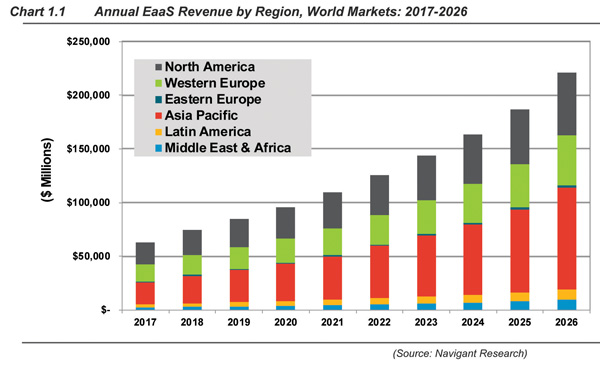In a recent report, Navigant is proposing that the power sector has evolved far enough from the traditional centralized generation model that it should start thinking about models for deploying energy as a set of service applications.
“The electric power industry is facing a fundamental shift from centralized generation toward a more decentralized grid known as the Energy Cloud,” Navigant argues in its report, Commercial and Industrial Energy as a Service Applications and Deployment Models: Global Market Analysis and Forecasts.
 What it’s calling the Energy Cloud “... consists of a mix of distributed energy resources (DER) technology and software solutions poised to disrupt traditional utility electricity procurement and delivery models. From a utility customer perspective, corporate commercial and industrial (C&I) energy and sustainability managers have had no say about the price and type of electricity they procure under traditional, regulated, and centralized grid models. Today, these managers are choosing to apply new technology and business model innovations driven by the Energy Cloud to meet energy needs. Navigant Research anticipates that these evolving grid and customer factors will converge to give rise to demand for vendor-based energy business model disruptors that can provide turnkey energy as a service (EaaS) solutions. Financing innovation will sit at the heart of this business model shift and facilitate the delivery of new customer choice options.”
What it’s calling the Energy Cloud “... consists of a mix of distributed energy resources (DER) technology and software solutions poised to disrupt traditional utility electricity procurement and delivery models. From a utility customer perspective, corporate commercial and industrial (C&I) energy and sustainability managers have had no say about the price and type of electricity they procure under traditional, regulated, and centralized grid models. Today, these managers are choosing to apply new technology and business model innovations driven by the Energy Cloud to meet energy needs. Navigant Research anticipates that these evolving grid and customer factors will converge to give rise to demand for vendor-based energy business model disruptors that can provide turnkey energy as a service (EaaS) solutions. Financing innovation will sit at the heart of this business model shift and facilitate the delivery of new customer choice options.”
The report suggests several EaaS applications, including energy portfolio advisory solutions, onsite and offsite energy supply, energy efficiency and building optimization solutions, and load management and optimization solutions. By 2026, it forecasts the annual global market for C&I EaaS as reaching US$221.1 billion. The largest region for C&I EaaS is expected to be Asia Pacific, where annual revenue is anticipated to reach $94.3 billion by 2026.
